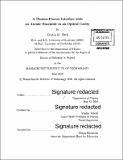| dc.contributor.advisor | Vladan Vuletić. | en_US |
| dc.contributor.author | Beck, Kristin M. (Kristin Marie) | en_US |
| dc.contributor.other | Massachusetts Institute of Technology. Department of Physics. | en_US |
| dc.date.accessioned | 2016-09-30T19:32:27Z | |
| dc.date.available | 2016-09-30T19:32:27Z | |
| dc.date.copyright | 2016 | en_US |
| dc.date.issued | 2016 | en_US |
| dc.identifier.uri | http://hdl.handle.net/1721.1/104501 | |
| dc.description | Thesis: Ph. D., Massachusetts Institute of Technology, Department of Physics, 2016. | en_US |
| dc.description | Cataloged from PDF version of thesis. | en_US |
| dc.description | Includes bibliographical references (pages 133-140). | en_US |
| dc.description.abstract | Since the emergence of quantum computing as a field, interactions between two-level systems that can carry quantum information have been conceptualized in terms of quantum devices. Here, I demonstrate four such devices for optical photons traveling in two different modes: an all-optical switch and transistor, a nondestructive photon detector, a phase shifter, and a quantum state generator. These devices rely on a nonlinear optical interface comprised of a few thousand atoms inside of a high-finesse optical cavity. Signal light is sent through a mode transverse to the cavity and is stored or travels through the atoms as a collective excitation. The corresponding atomic population couples to the cavity mode's optical field. The strength of the resulting photon-photon interaction is governed by the optical depth of the atoms for the signal light, and the strong atom-photon coupling in the optical cavity. I first demonstrate an all-optical switch and transistor using blocking interactions that reduce the cavity's transmission by a factor of 11 +/- 1 in the presence of a stored signal photon. This interaction creates anticorrelations between the output light in the signal and cavity paths. I show that these anticorrelations persist in time continuous operation when the photon signal and cavity arrive at the same time. Then, I turn to photon detection. I reconfigure the system and reconceptualize it as a nondestructive, cavity-based detector for signal light. I demonstrate strong correlations between this nondestructive detection and a subsequent destructive detection with non-destructive detection efficiency of 0.5%. Next, I show that a single cavity photon can shift the phase of stored signal light by up to 1.0 +/- 0.4 rad and demonstrate entanglement between output cavity and signal photons. Finally, I present recent experiments where this entanglement is used to modify the phase and amplitude of the signal light by making a projective measurement on the cavity light. | en_US |
| dc.description.statementofresponsibility | by Kristin M. Beck. | en_US |
| dc.format.extent | 140 pages | en_US |
| dc.language.iso | eng | en_US |
| dc.publisher | Massachusetts Institute of Technology | en_US |
| dc.rights | M.I.T. theses are protected by copyright. They may be viewed from this source for any purpose, but reproduction or distribution in any format is prohibited without written permission. See provided URL for inquiries about permission. | en_US |
| dc.rights.uri | http://dspace.mit.edu/handle/1721.1/7582 | en_US |
| dc.subject | Physics. | en_US |
| dc.title | A photon-photon interface with an atomic ensemble in an optical cavity | en_US |
| dc.type | Thesis | en_US |
| dc.description.degree | Ph. D. | en_US |
| dc.contributor.department | Massachusetts Institute of Technology. Department of Physics | |
| dc.identifier.oclc | 958278754 | en_US |
